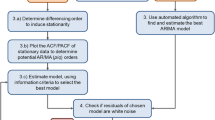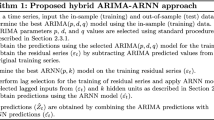Abstract
The US housing market has experienced significant cyclical volatility over the last twenty-five years due to major structural changes and economic fluctuations. In addition, the housing market is generally considered to be weak form inefficient. Houses are relatively illiquid, exceptionally heterogeneous, and are associated with large transactions costs. As such, past research has shown that it is possible to predict, at least partially, the time path of housing prices. The ability to predict housing prices is important such that investors can make better asset allocation decisions, including the pricing and underwriting of mortgages. Most of the prior studies examining the US housing market have employed constant coefficient approaches to forecast house price movements. However, this approach is not optimal as an examination of data reveals substantial sub-sample parameter instability. To account for the parameter instability, we employ alternative estimation methodologies where the estimated parameters are allowed to vary over time. The results provide strong empirical evidence in favor of utilizing the rolling Generalized Autoregressive Conditional Heteroskedastic (GARCH) Model and the Kalman Filter with an Autoregressive Presentation (KAR) for the parameters’ time variation. Lastly, we provide out-of-sample forecasts and demonstrate the precision of our approach.
Similar content being viewed by others
References
Abraham, J. M., and P. H. Hendershott. (1996). “Bubbles in Metropolitan Housing Markets,” Journal of Housing Research 7, 191–207.
Albert, W. W. (1962). “Business Cycles, Residential Construction Cycles, and the Mortgage Market,” Journal of Political Economics 70(3), 263–281.
Brady, E. A. (1967). “A Sectoral Econometric Study of the Postwar Residential-Housing Market,” Journal of Public Economy 75(2), 147–158.
Bowden, R. J. (1980). Equilibrium and Disequilibrium in the Housing Market; A Survey in Housing Economics, Paper Prepared for the National Housing Economics Conference 1978, Australian Government Publishing Service (AGPS).
Breedon, F. J. and M. Joyce. (1993). House Prices, Arrears and Possessions: A Three Equation Model for the UK, Bank of England Working Paper No. 14.
Brown, J. P., K. Song, and A. McGillivray. (1997) “Forecasting UK House Prices: A Time Varying Coefficient Approach,” Economic Modeling 14, 529–548.
Buckley, R, and J. Ermisch. (1982). Government Policy and House Prices in the United Kingdom: An Econometric Analysis. Oxford Bulletin, 14, 273–304.
Clapp, J., and C. Giaccotto. (2002). “Evaluating House Price Forecasts,” Journal of Real Estate Research 24, 1–26.
Crawford, G., and M. Fratantoni. (2003). “Assessing the Forecasting Performance of Regime-Switching, ARIMA and GARCH: Models of House Prices,” Real Estate Economics 31(2), 223–243.
DiPasquale, D., and W. C. Wheaton. (1994). “Housing Market Dynamics and the Future of Housing Prices,” Journal of Urban Economics 35, 1–27.
Doan, T., R. Litterman, and C. Sims. (1984). “Forecasting and Conditional Projection Using Realistic Prior Distributions,” Econometric Review 3, 1–100.
Engle, R., and C. W. J. Granger. (1987). “Cointegration and Error Correction: Representation, Estimation, and Testing,” Econometrica 55, 251–76, March.
Engle, R., and M., Watson. (1987). The Kalman Filter: Applications to Forecasting and Rational-Expectations Models. In T. Bewley. (ed. ), Advances in Econometrics Fifth World Congress, vol I. Cambridge University Press: Cambridge, pp. 245–283.
Francke, M., and A. de Vos. (2000). “Efficient Computation of Hierarchical Trends,” Journal of Business and economic Statistics 18, 51–57.
Giaccotto, C., and J. Clapp. (1992). “Appraisal-Based Real Estate Returns Under Alternative Market Regimes,” Journal of the American Real Estate and Urban Economics Association 20, 1–24.
Goetzmann, W. N., and M. Spiegel. (1997). “A Spatial Model of Housing Returns and Neighborhood Substitutability” Journal of Real Estate Finance and Economics 14(1), 11–31.
Hall, S., Z. Psaradakis, and M. Sola. (1997). “Switching Error—Correcting Models of House Prices in the United Kingdom,” Economic Modeling 14, 517–527.
Holly, S., and N. Jones. (1997). “House Prices Since the 1940s: Cointegration, Demography and Asymmetries,” Economic Modeling 14, 549–565.
Huang, D. S. (1966). “The Short-Term Flows of Nonfarm Residential Mortgage,” Econometrica 34(2), 433–459.
Johansen, S. (1988). “Statistical Analysis of Cointegration Vectors,” Journal of Economic Dynamics and Control 12, 1551–1580.
Lucas, R. E. (1976). Econometric Policy Evaluation: A Critique. In K. Brunner and A. Meltzer (eds.), The Phillips Curve and Labour Markets, Carnegie Rochester Conference in Public Policy, North Holland, Amsterdam.
Quigley, J. M. (1995). “A simple Hybrid Model for Estimating Real Estate Price Indexes,” Journal of Housing Economics 4, 1–12.
Maisel, S. J. (1963). “A Theory of Fluctuations in Residential Construction Starts,” American Economic Review 53(3), 359–383.
Malpezzi, S. (1999). “A Simple Error Correction Model of House Prices,” Journal of Housing Economics 8, 27–62.
Mankiw, N. G. and D. N. Weil. (1989). “The Baby Boom, the Baby Bust, and the Housing Market,” Regional Science and Urban Economics 19, 235–258.
Meen, G. P. (1990). “The Removal of Mortgage Market Constraints and the Implications for Econometric Modeling of UK House Prices,” Oxford Bulletin of Economics and Statistics 52: 1–23.
Meen, G. P. (1996). “Ten Proposition in UK Housing Macroeconomics” An Overview of the 1980’s and Early 1990s, Urban Studies 33, 425–446.
Muth, R. F. (1960). The Demand for Non-Farm Housing, in “The Demand for Durable Goods.” University of Chicago Press: Chicago.
Pain, N., and P., Westaway. (1997). “Modeling Structural Change in the UK Housing Market: a Comparison of Alternative House Price Models,” Economic Modeling, 14: 587–610.
Peek, J., and J. A. Wilcox. (1991). “The Measurement and Determinants of Single-Family-House Prices,” AREUEA Journal 19, 353–382.
Poterba, J.M. (1984). “Tax Subsidies to Owner-Occupied Housing: An Asset Market Approach,” Quarterly Journal of Economics 4, 729–752.
Shiller, R. J. (1993). Macro Markets. Oxford: Oxford University Press.
Author information
Authors and Affiliations
Corresponding author
Rights and permissions
About this article
Cite this article
Guirguis, H.S., Giannikos, C.I. & Anderson, R.I. The US Housing Market: Asset Pricing Forecasts Using Time Varying Coefficients. J Real Estate Finan Econ 30, 33–53 (2005). https://doi.org/10.1007/s11146-004-4830-z
Issue Date:
DOI: https://doi.org/10.1007/s11146-004-4830-z




